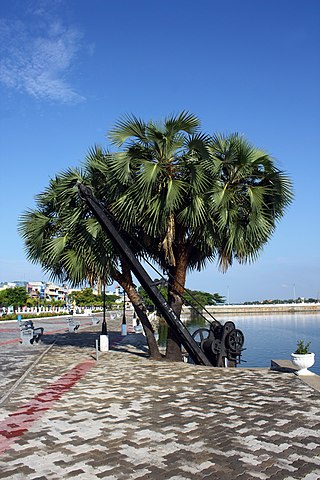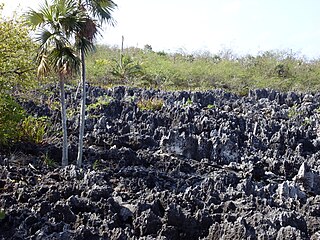
The Arecaceae is a family of perennial, flowering plants in the monocot order Arecales. Their growth form can be climbers, shrubs, tree-like and stemless plants, all commonly known as palms. Those having a tree-like form are called palm trees. Currently, 181 genera with around 2,600 species are known, most of which are restricted to tropical and subtropical climates. Most palms are distinguished by their large, compound, evergreen leaves, known as fronds, arranged at the top of an unbranched stem, except for the Hyphaene genus, who has branched palms. However, palms exhibit an enormous diversity in physical characteristics and inhabit nearly every type of habitat within their range, from rainforests to deserts.

Hyphaene thebaica, with common names doum palm and gingerbread tree, is a type of palm tree with edible oval fruit. It is a native to the Arabian Peninsula and also to the northern half and western part of Africa where it is widely distributed and tends to grow in places where groundwater is present.

Sago palm is a common name for several plants which are used to produce a starchy food known as sago. Sago palms may be "true palms" in the family Arecaceae, or cycads with a palm-like appearance. Sago produced from cycads must be detoxified before consumption. Plants called sago palm include:
Cabbage palm is a common name for several species of palms or palm-like plants:

Palm sugar is a sweetener derived from any variety of palm tree. Palm sugar is sometimes qualified by the type of palm, as in coconut palm sugar. While sugars from different palms may have slightly different compositions, all are processed similarly and can be used interchangeably.
Cabbage tree is a common name for several plant species:

Coccothrinax is a genus of palms in the family Arecaceae. There are more than 50 species described in the genus, plus many synonyms and subspecies. A new species was described as recently as 2017. Many Coccothrinax produce thatch. In Spanish-speaking countries, guano is a common name applied to Coccothrinax palms. The species are native throughout the Caribbean, the Bahamas, extreme southern Florida and southeastern Mexico, but most of the species are known only from Cuba.
Mahoe is a common name for several plants and may refer to:
Trumpet tree or trumpet bush may refer to:

A palapa is an open-sided dwelling with a thatched roof made of dried palm leaves. It is very useful in hot weather and, therefore, very common on Mexican beaches and deserts.

Manicaria is a palm genus which is found in Trinidad, Central and South America. It contains two recognized species:
- Manicaria martianaBurret – Colombia, northwestern Brazil
- Manicaria sacciferaGaertn. – Central America, Trinidad, Venezuela, Colombia, Ecuador, Peru, northwestern Brazil

Chelyocarpus is a genus of small to medium-sized fan palms which are native to northwestern South America. Some are upright trees, while others creep along the ground. Species are used for thatch, to weave hats, stuff pillows and as a source of salt.

Phoenicophorium, the thief palm, is a monotypic genus of flowering plant in the family Arecaceae. The sole species is Phoenicophorium borsigianum.
Coccothrinax jamaicensis, the silver thatch or Jamaican silver thatch, is a fan palm that is endemic to Jamaica.

Eugeissona is a clustering genus of flowering plant in the palm family native to Borneo, Thailand and Malaysia. The six monoecious species provide a wide range of local uses and are commonly called bertam or wild Bornean sago. The genus is the sole representative of the Eugeissoninae having very few obvious relatives; the hermaphrodite and staminate flowers are also found in Metroxylon, however the other specialized characteristics are unique suggesting an early split and differentiation from other members of the Calameae. Fossilized pollen belonging to these plants has been recovered in the lower and middle Miocene deposits in Sarawak. The name is from two Greek words meaning "good" and "roof", due to their common use in roof thatching.

Leucothrinax morrisii, the Key thatch palm, is a small palm which is native to the Greater Antilles, northern Lesser Antilles, The Bahamas and Florida and the Florida Keys in the United States.

Attalea phalerata is a species of palm tree known by the English common name urucuri palm, the Portuguese common name urucurizeiro, and the Spanish common name shapaja. Other common names include motacu and bacuri. It is native to Brazil, Bolivia, Paraguay, and Peru, where it grows along southern and western Amazonia. It is the most common palm tree on the Pantanal.
Latanier palm is a common name for several plants in palm family (Arecaceae) and may refer to:

Thrinax radiata, also known as the Florida thatch palm, is a medium to slow growing palm in the family Arecaceae. It is native to many Caribbean islands, Mexico, Central America, and far southern Florida. Its natural habitat is sandy, calcareous soil in coastal areas.

The Cayman Islands xeric scrub ecoregion covers a portion of the Cayman Islands in the Caribbean Sea. The dry ('xeric') parts of the island are surrounded by mangroves, dry forest, or developed areas. Grand Cayman Island has been heavily cleared or degraded for human development; while the less populated islands have more intact shrub and wooded habitat.
This page is based on this
Wikipedia article Text is available under the
CC BY-SA 4.0 license; additional terms may apply.
Images, videos and audio are available under their respective licenses.













